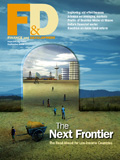 View this Issue Archive of F&D Issues Subscribe to Print Edition Write to us F&D welcomes comments and brief letters, a selection of which are posted under Letters to the Editor. Letters may be edited. Please send your letters to: fanddletters@imf.org. F&D Magazine Free Email Notification Receive emails when we post new
items of interest to you. |
Spending on the MDGs Could countries handle a sudden doubling in their aid? What would they spend the increased aid on, and how can we ensure that the additional spending will reduce poverty? The IMF is part of a multinational effort to find out. And time is short, because the world’s major industrial countries have pledged to double the aid they give to sub-Saharan Africa by 2010. The IMF is working on 10 African country case studies to assess the economic effects of the spending of increased aid. The idea is to find out whether a dramatic boost in aid, promised at the G-8 Gleneagles Summit in 2005, can help countries meet the poverty-fighting Millennium Development Goals (MDGs). The project was conceived in September 2007, when the United Nations established an MDG Africa Steering Group, which brings together the leaders of multilateral institutions—including the IMF—to identify practical steps needed for Africa to achieve the MDGs. A working group is looking at issues such as education, agriculture, health, trade, statistics, aid predictability, and how development partners can work more effectively on the ground to help Africa reach the MDGs. The IMF has developed scenarios that will show how macroeconomic policy can be designed to fully spend and absorb the international commitments, which doubles aid to Africa to an average of $105 per capita by 2010. The scenarios are currently being calibrated for use in the case-study countries—Benin, the Central African Republic, Ghana, Liberia, Niger, Rwanda, Sierra Leone, Tanzania, Togo, and Zambia. The scenarios are based on sector-wide expenditure analyses by the country authorities and development partners. Among other approaches, the IMF is using a new, state-of-the-art model to analyze the effects of increased aid on key variables such as real growth, inflation, the exchange rate, and the current account balance, and to assess how different policy choices can help or hinder progress. The model looks, in particular, for possible “Dutch disease” effects. These occur when aid surges lead to real exchange rate appreciations that make exports more expensive. A first set of results for an initial set of countries is expected in September 2008. The work on the remaining countries will be completed before the end of 2008. The recommendations of the MDG Africa Steering Group—and more details on the entire effort—are available at www.mdgafrica.org. Power in the wind Prompted by climate change concerns, increased international support, surging oil prices, and continuing anxiety about energy security, investment in renewable energy and energy efficiency reached a record high in 2007, the United Nations Environment Program reported. The agency’s report, Global Trends in Sustainable Energy Investment 2008, found that, in spite of the subprime mortgage crisis that engulfed global markets, new investment in clean energy reached nearly $150 billion in 2007, up 60 percent from the year before. Wind energy captured most of the new funding with more than $50 billion, with solar power gaining almost $30 billion. For greenhouse gas reduction and efficiency targets to be met, investment in sustainable energy must continue its strong growth, the study cautioned. Investment in the sustainable energy sector is expected to reach $450 billion a year by 2012, surging to over $600 billion a year in 2020. The sector’s overall performance during 2007 and into 2008 sets it on track to achieve these levels, the report noted. Events in 2008 September 2–4, Accra, Ghana September 22, New York, USA September 25, New York, USA October 10–13, Washington, DC, USA November 8–9, São Paulo, Brazil November 13–14, Washington, DC, USA November 29–December 2, Doha, Qatar |